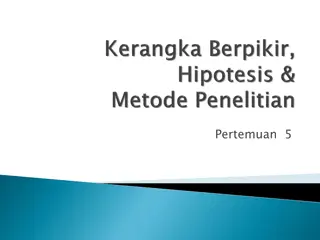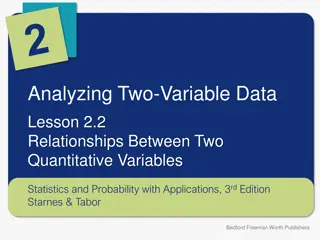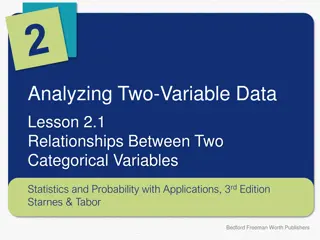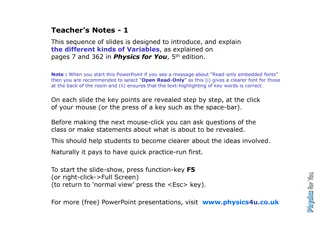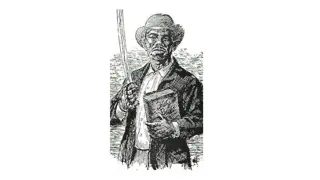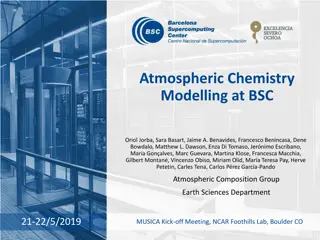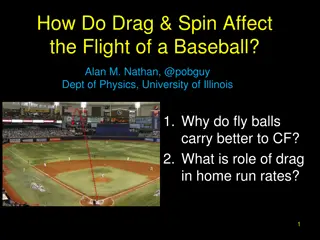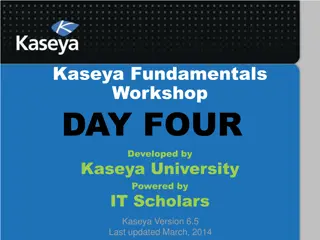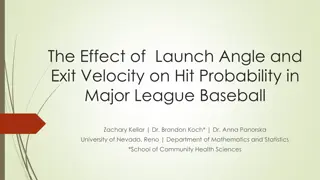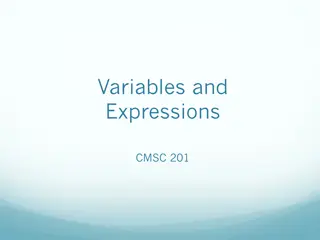Analyzing Atmospheric Variables and Baseball Statistics at Turner Field
This study analyzes the impact of atmospheric variables on baseball statistics at Turner Field, focusing on regular season games from 1997 to 2013. The research examines correlations between weather conditions and offensive/pitching performance, providing insights into the relationships between temperature, sky condition, and game outcomes.
Download Presentation

Please find below an Image/Link to download the presentation.
The content on the website is provided AS IS for your information and personal use only. It may not be sold, licensed, or shared on other websites without obtaining consent from the author.If you encounter any issues during the download, it is possible that the publisher has removed the file from their server.
You are allowed to download the files provided on this website for personal or commercial use, subject to the condition that they are used lawfully. All files are the property of their respective owners.
The content on the website is provided AS IS for your information and personal use only. It may not be sold, licensed, or shared on other websites without obtaining consent from the author.
E N D
Presentation Transcript
Analyzing Atmospheric Variables and Baseball Statistics at Turner Field Steve Gregg EAS 4480 Data Analysis April 24th, 2014
Overview Motivation Data and Sources Methods Results Summary
Motivation Figure 1. From Jason Samenow, Capital Weather Gang, Washington Post. Temperatures compared to a 1951-1980 baseline since 1880 and the average home runs per team per game since 1880.
Motivation Figure 2. From Alan M. Nathan, Baseball Prospectus. For a given home run hit at temp T, R-R1 is the extra distance the ball travels at that temperature relative to how far it would have traveled had the temperature been 72.7 F. Plot shows the average value of R-R1 for each temperature bucket, slope of line is 0.25 ft/ F.
Data and sources Focus on Turner Field regular season games from 1997 2013 ( 1300 games) Baseball data from retrosheet.org Offensive stats: total home runs and runs per game Pitching stats: total strikeouts and walks per game Weather data from Iowa State University s archive of Automated Surface Observing Network (ASOS) Weather data: Temperature, dew point, relative humidity, MSLP, cloud cover Figure 3. Locations of Turner Field and ASOS station at Hartsfield-Jackson International Airport. Distance between them approximately 7 miles.
Methods Correlation coefficients calculated to determine a statistically significant relationship Regression analysis used to identify whether least squares, RMA, or PC best for data. Bootstrap done for LSR slope and correlation coefficient.
Results: Sky condition Impact Sky condition only impacts day games CLR vs. OVC only Day games significantly smaller sample (387 games, 29%) Unexpected results for strikeouts, compared to Kent and Sheridan, 2011 Figure 4. Sky conditional impact for day games at Turner Field, 1997-2014.
Results: Correlations Overall low correlations somewhat surprising Only two statistically significant (p < 0.05) correlations Two also within the CC 95% confidence interval HR and temperature p = 0.032 (CI: 0.0051 to 0.1149) Walks and temperature p = 0.001 (CI: -0.146 to -0.037) Temp Dew Point RH MSLP Home runs 0.0602 0.0169 -0.0404 -0.0361 Runs -0.0025 0.0154 0.0225 -0.0073 Strikeouts -0.053 -0.025 0.0311 0.3481 Walks - 0.0916 -0.0519 0.031 -0.0171 Table 1. Correlation Coefficients. Red indicates statistically significant.
Results: LSR regressions Figure 6. LSR run vs. temperature Figure 5. LSR home run vs. temperature Figure 7. LSR walks vs. temperature
Results: Home run regressions Slopes LSR PC 0.089 0.009 LSR slope 95% CI Lower Upper -0.2793 0.297 R2 (variance) LSR PC 0.0036 0.872 Figure 8. LSR, RMA, and PC regression fit comparison for home run vs. temperature.
Results: Home run residuals Residual Chi-squared Chi critical value LSR chi- squared value PC chi- squared value 46.2 2.11e3 2.11e3 Figure 9. Stem plot of LSR and PC residuals. Residuals taken and tested. Chi-squared test for LSR and PC residuals indicates that neither are normally distributed.
Results: Bootstrap LSR slope, correlation coefficient Bootstrap Mean LSR slope (original) Mean correlation coefficient (original) 0.0087 0.061 CI: 0.0085 to .0090 (0.0089 CI: -0.279to0.297) CI:0.059 to 0.063 (0.060 CI: 0.0051 to 0.1149) Figure 10. Histogram of bootstrapped slope and correlation coefficient. Bootstrap mean slope and mean CC similar to original. Bootstrap chi-squared test confirms what we already knew: data not normally distributed.
Summary Physics of baseball tell us that temperature, dew point, and other variables should have impact on ball flight (batters) and ball movement (pitchers). Correlation of temperature and home runs and walks at Turner Field not high but it is statistically significant. Too many other non atmospheric factors: baseball is a game of inches . Non-normality of data does call into question confidence intervals for regression analysis.


